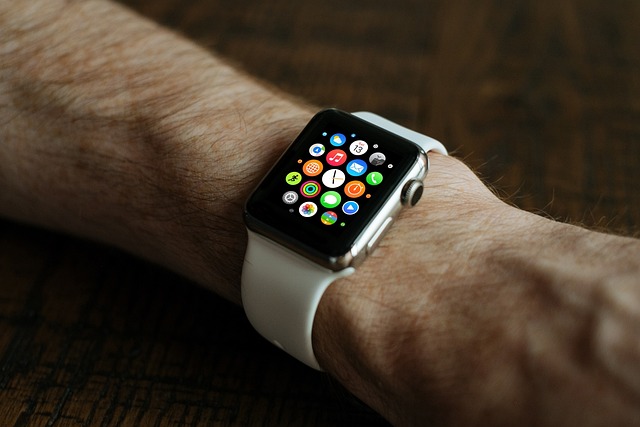When replacing an Apple Watch battery, it's essential to understand the impact on its performance and health tracking accuracy. A fresh battery can improve charge retention and potentially extend time between charges due to the new battery's full capacity. However, to ensure accurate health data post-replacement, expert calibration of both hardware and software is critical. This process includes synchronizing the watch with a reliable time source, compensating for any discrepancies from the battery replacement, and correcting settings to maintain sensor accuracy. Additionally, updating watchOS software immediately after the battery service is necessary for device compatibility and performance. It's also important to verify the Apple Watch's water resistance post-service, as battery maintenance can sometimes affect this feature. To maintain your Apple Watch's longevity and peak condition, adhere to regular software updates, monitor battery usage, follow proper charging practices, and consider authorized service providers for checkups and guidance on preserving both the battery and other components. This proactive approach ensures that your Apple Watch continues to provide accurate timekeeping, health monitoring, and overall reliable functionality.
When a device as sophisticated as an Apple Watch requires maintenance, such as replacing its battery, understanding the subsequent steps for optimal performance is key. This article delves into the critical care required post-replacement to maintain the watch’s precision timekeeping, functionality, and water resistance. We explore the importance of professional service, calibration adjustments, setting corrections, software updates, and maintenance routines to ensure long-term durability and extend the lifespan of your Apple Watch after a battery replacement.
- Understanding the Impact of Battery Replacement on Apple Watch Performance
- The Role of Professional Care Post-Battery Replacement for Optimal Functionality
- Ensuring Precision: Calibration and Setting Correction After Replacing an Apple Watch Battery
- The Importance of Software Update Coordination Post-Battery Replacement
- Preserving Water Resistance: A Critical Check Following Battery Service
- Long-Term Durability: How Proper Maintenance After Battery Replacement Extends Apple Watch Lifespan
Understanding the Impact of Battery Replacement on Apple Watch Performance

When considering the replacement of an Apple Watch battery, it’s crucial to comprehend the subsequent impact on the device’s performance. The Apple Watch, like any electronic device, relies heavily on its battery for optimal operation. A depleted battery not only affects the watch’s ability to function for its intended use, such as tracking fitness activities or providing notifications, but it also influences the longevity and efficiency of its various features. Upon replacing the Apple Watch battery, users may notice immediate improvements in how the device holds a charge, with a potential increase in battery life between charges. This enhancement is due to the new battery’s capacity being at its maximum when installed, counteracting the gradual loss of charge storage that occurs over time in older batteries.
Moreover, post-replacement, it’s pivotal to recalibrate the Apple Watch to ensure accurate readings for health metrics like heart rate and blood oxygen levels. The recalibration process allows the watch to adapt to the newly replaced battery, which can slightly differ from the original one in terms of voltage and capacity. This step is instrumental in maintaining the reliability and precision of data that users have come to expect from their Apple Watch, particularly for those who monitor their health closely. Additionally, the recalibration process may necessitate a full charge cycle before the device’s battery indicator accurately reflects the remaining charge. Understanding these nuances post-replacement is key to maximizing the performance and longevity of your Apple Watch after battery replacement.
The Role of Professional Care Post-Battery Replacement for Optimal Functionality

When your Apple Watch’s battery begins to wane, replacing it can breathe new life into your device, enhancing its performance and reliability. Post-replacement care is pivotal in ensuring the battery functions optimally. A professional service provider, versed in the intricacies of Apple Watch maintenance, will not only replace the battery with precision but also calibrate the software to recognize the new energy capacity. This synchronization is essential for the longevity and efficiency of your watch’s battery life. The expert will perform a full charge-discharge cycle to recalibrate the battery gauge accurately, ensuring the device can maintain optimal timekeeping and health monitoring functions. Furthermore, such professionals will often provide guidance on how to maintain the health of your new battery, including tips on charging habits and avoiding extreme temperatures that could affect battery performance. By opting for professional care after replacing an Apple Watch battery, you are investing in the longevity and continued accuracy of your device’s operation.
Ensuring Precision: Calibration and Setting Correction After Replacing an Apple Watch Battery

When replacing an Apple Watch battery, precision is paramount to ensure the device functions optimally. Post-replacement, the Apple Watch must undergo careful calibration to align with the timekeeping accuracy users are accustomed to. Calibration involves synchronizing the watch’s internal clock with a known time source, typically an atomic or radio clock. This process is critical as it compensates for any deviations that may have occurred during battery replacement and realigns the watch’s movements with standard time, ensuring its reliability.
Furthermore, setting correction is another essential step after battery replacement. This correction accounts for any positional changes to the watch’s sensors and components during the repair process. Properly adjusting the settings post-replacement corrects any inaccuracies that could arise from a shift in position. For instance, the orientation of the accelerometer and gyroscope might have been altered, which can affect the health metrics and notifications the watch provides. By addressing these changes, the Apple Watch’s functionality is restored to its pre-replacement state, maintaining the integrity of its features, including its heart rate monitoring capabilities and workout tracking. Replacing an Apple Watch battery requires more than just swapping out the old for the new; it demands a meticulous approach to calibration and setting correction to preserve the watch’s performance and user experience.
The Importance of Software Update Coordination Post-Battery Replacement

When replacing an Apple Watch battery, ensuring the synchronization of software updates is a critical aspect of the post-replacement process. The software on an Apple Watch interacts closely with the watch’s hardware, and a freshly installed battery may not be fully compatible with the existing software version. To avoid potential issues, it’s advisable to update the watchOS software after the battery replacement service is completed. This update can enhance device performance, extend battery life, and ensure that all functions work as intended with the new battery. Coordinating this update soon after the replacement procedure minimizes the risk of firmware inconsistencies, which could affect the precision and reliability of health and fitness metrics, notifications, and overall user experience. Moreover, as the Apple Watch relies on a seamless interplay between its hardware and software components, completing the update promptly can safeguard against any anomalies that might arise from the battery change. To replace an Apple Watch battery effectively, it’s essential to consider the timing of the software update alongside the replacement itself for optimal performance and functionality post-service.
Preserving Water Resistance: A Critical Check Following Battery Service

When a battery service is performed on an Apple Watch, it’s imperative to ensure that the device’s water resistance is preserved. This is because the integrity of the seal around the battery and the casing can be compromised during the replacement process. It’s crucial for users to verify that the watch is still water-resistant post-service to prevent potential moisture damage, which could lead to more complex issues such as corrosion or short circuits. The Apple Watch’s water resistance feature is a critical aspect of its design, allowing users to engage in activities like swimming or showering without worry. To maintain this functionality after replace apple watch battery, the service provider must follow precise procedures, including testing the watch’s seal against water intrusion. This involves checking for leaks and ensuring that all rubber seals are properly replaced and seated. By adhering to these steps, users can be confident that their Apple Watch will continue to provide the protection it is designed for after battery replacement.
Long-Term Durability: How Proper Maintenance After Battery Replacement Extends Apple Watch Lifespan

Following the replacement of your Apple Watch battery, consistent maintenance is key to ensuring its long-term durability and optimal performance. Post-replacement care involves not only handling the device with care to prevent physical damage but also regularly updating its software. These updates can improve battery life and overall system efficiency. Additionally, monitoring the battery usage through the watch’s settings and charging the device as recommended by Apple can further extend its lifespan. Proper maintenance after replacing an Apple Watch battery not only preserves its newly refreshed power cell but also safeguards against premature wear and tear on other components. By adhering to best practices for care and maintenance, you can maximize the functional years of your Apple Watch, ensuring it remains a reliable companion for all your timekeeping and health-tracking needs. Regular checkups with authorized service providers can also help identify potential issues before they become significant problems, further contributing to the longevity of your device.
Upon replacing an Apple Watch battery, it is imperative to prioritize professional care and subsequent maintenance to restore and maintain its performance. This process not only revitalizes the device’s functionality but also ensures accurate timekeeping, optimal operation, and preserves features such as water resistance. Post-service software updates are crucial for compatibility and efficiency. By adhering to these steps, watch owners can extend their Apple Watch’s lifespan and enjoy its benefits for years to come. When considering a battery replacement for your Apple Watch, professional assistance guarantees the device operates at its best, safeguarding your investment and enhancing overall user experience.
